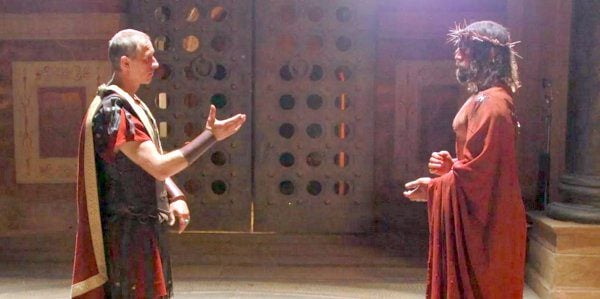 CNN and other major news organizations have come under fire in recent months for propagating shaky stories, but in its “Finding Jesus: Faith. Fact. Forgery,”, the cablenet plays it straight.
CNN and other major news organizations have come under fire in recent months for propagating shaky stories, but in its “Finding Jesus: Faith. Fact. Forgery,”, the cablenet plays it straight.
The one-hour series returns for a second season on Sunday, March 5, at 9 p.m. ET, followed by the premiere of another religion-themed show, “Believer With Reza Aslan.”
Well, at least CNN’s batting .500 with these. First, the good.
“Finding Jesus” returns with “The Pilate Stone.” The conceit of the series is that it takes a historical artifact and examines its validity and its connection to New Testament accounts. In this case, it’s a slab of stone whose inscription references Pontius Pilate, whose name has passed into history — and infamy — as the Roman who pronounced the death sentence on Christ.
https://youtu.be/cyHa0ROV3Xg
“Finding Jesus” blends expert interviews with on-location footage and recreations of episodes from Jesus’ life. It avoids the breathless, Dan-Brown-ish tone of some cable documentaries about Biblical subjects, while still being respectful of the source material.
The producers of “Finding Jesus” want to not only speak to believers, but also to skeptics. The evidence is presented, and conclusions are left to viewers.
From Townhall.com:
Pastor A.R. Bernard, who contributes analysis on the series, says the program is not only for religious viewers.
“There are a lot of people who are still seeking Jesus,” Bernard said in an interview with Townhall. “He is the most debated figure in the last 2,000 years. And people are still trying to make sense of it and the Christian religion.”
In 2015, when the series premiered, I talked to Catholic convert David Gibson, co-author (with Michael McKinley) of the book that inspired the series, “Finding Jesus: Faith. Fact. Forgery.”
He said:
Rather than discrediting and running away from the historical Jesus and the quest for the Jesus of history, we have to double down. You have to go back and look at what’s really true and what is not, ask, what do we know? I don’t think there’s any reason to be afraid of that. It can actually deepen faith.
Jesus was not a myth. I have to say, in most of our chapters, and in the TV show, when you follow the trail, and you look at all the theories, you wind up, for the most part, back at the canonical Gospels.
And:
There an be a fear of historical research by some believers, and this kind of thing [the book and the CNN series] is a good antidote to fundamentalism on both sides — the fundamentalist Christians who want to say, “We don’t need to use our brains and reason; we don’t need to use historical research; we know what we know, and we don’t want to hear anything else”; and fundamentalist atheists on the other side who want to say, “No, we want to use this history to undermine everything you believe.”
Well, you know what, neither works. Research and looking at the Gospels and looking at the Scripture can really only deepen one’s faith and certainly deepen the conversation, whether you believe or you don’t.
The rest of the episodes are “Raising Lazarus” (March 12), “The Childhood Home of Jesus” (March 19), “The Tomb of King Herod” (March 26), “The Bones of St. Peter” (April 2), “Doubting Thomas” (April 9).
In contrast with “Finding Jesus,” CNN then offers “Believer With Reza Aslan,” a six-part series featuring the Iranian-American religion scholar, who wrote a widely criticized biography (or, as some have characterized it, historical-fiction account) of Christ, called “Zealot: The Life and Times of Jesus of Nazareth.” In it, Aslan characterized Jesus as as a political figure calling for the end of Roman rule, rather than the Messiah.
Regarding the book, from Catholic apologist Jimmy Akin:
Drawing on the facts that Jesus led a popular movement in Palestine and that the Romans crucified him, Aslan adds a third supposed fact:
Crucifixion was a punishment that Rome reserved almost exclusively for the crime of sedition.
He then infers that Jesus must have been guilty of sedition and re-casts him in the role of one of the many political revolutionaries of the day who tried to throw off Roman rule, only to get squashed.
This is where the book gets its title—Zealot. The claim is that Jesus was just one of the many zealot-like revolutionaries of the time.
Aslan then cherry-picks the evidence of the gospels, accepting whatever agrees with his thesis and discarding everything that doesn’t.
Based on this notoriety, the Los Angeles-based Aslan has become a go-to-guy of sorts for Hollywood, including consulting on ABC’s short-lived Old Testament drama, “Of Kings and Prophets.”
Now he’s doing “Believer.”
The CNN press release describes the show thus:
The spiritual adventure series follows religion scholar and best-selling author Aslan as he immerses himself in customs and faith rituals around the globe, exploring Ultra-Orthodox Judaism in Israel, Scientology in the U.S., Hindu asceticism in India, Vodou in Haiti, Santa Muerte in Mexico, and an apocalyptic doomsday cult in Hawaii. The hour-long series, produced by Whalerock Industries with executive producers Aslan, Lloyd Braun, Liz Bronstein and Chris Cowan, will also air on CNN International.
Not even the Los Angeles Times was impressed with”Believer”:
But “Believer” doesn’t offer as much enlightenment as its title and premise might suggest. The main problem here is that some of the chosen believers in the first few episodes are ultimately unbelievable.
Many of the groups and leaders featured here are so fringe that their bizarre philosophies and theatrics distract from Aslan’s main mission — to demystify lesser understood faiths and find a commonality that makes us all believers in something.
So, my advice would be, say yes to “Finding Jesus,” but no to “Believer.”
Image: Courtesy CNN
Don’t miss a thing: head over to my other home, as Social Media Manager at Family Theater Productions; and check out FTP’s Faith & Family Media Blog.













